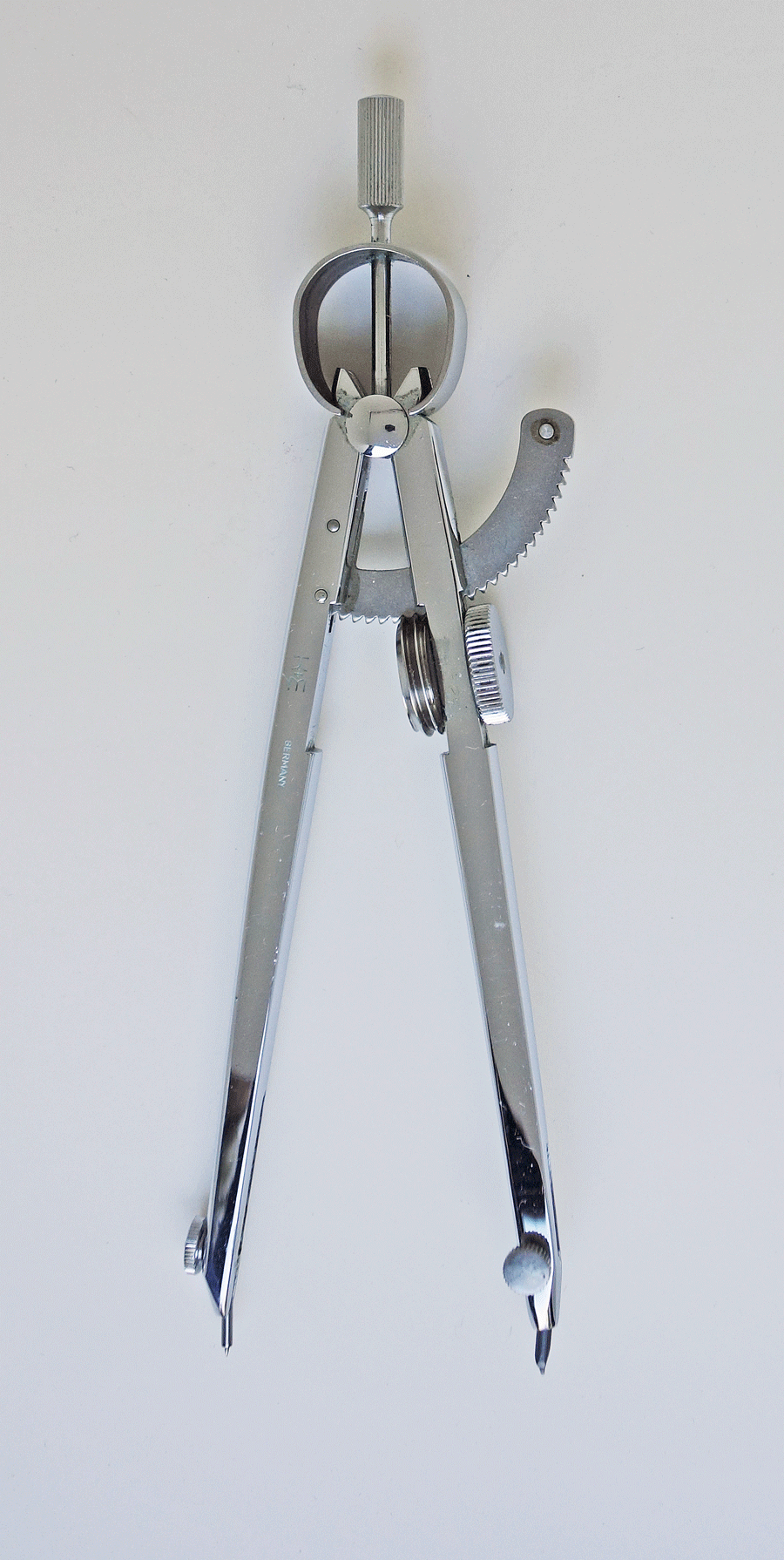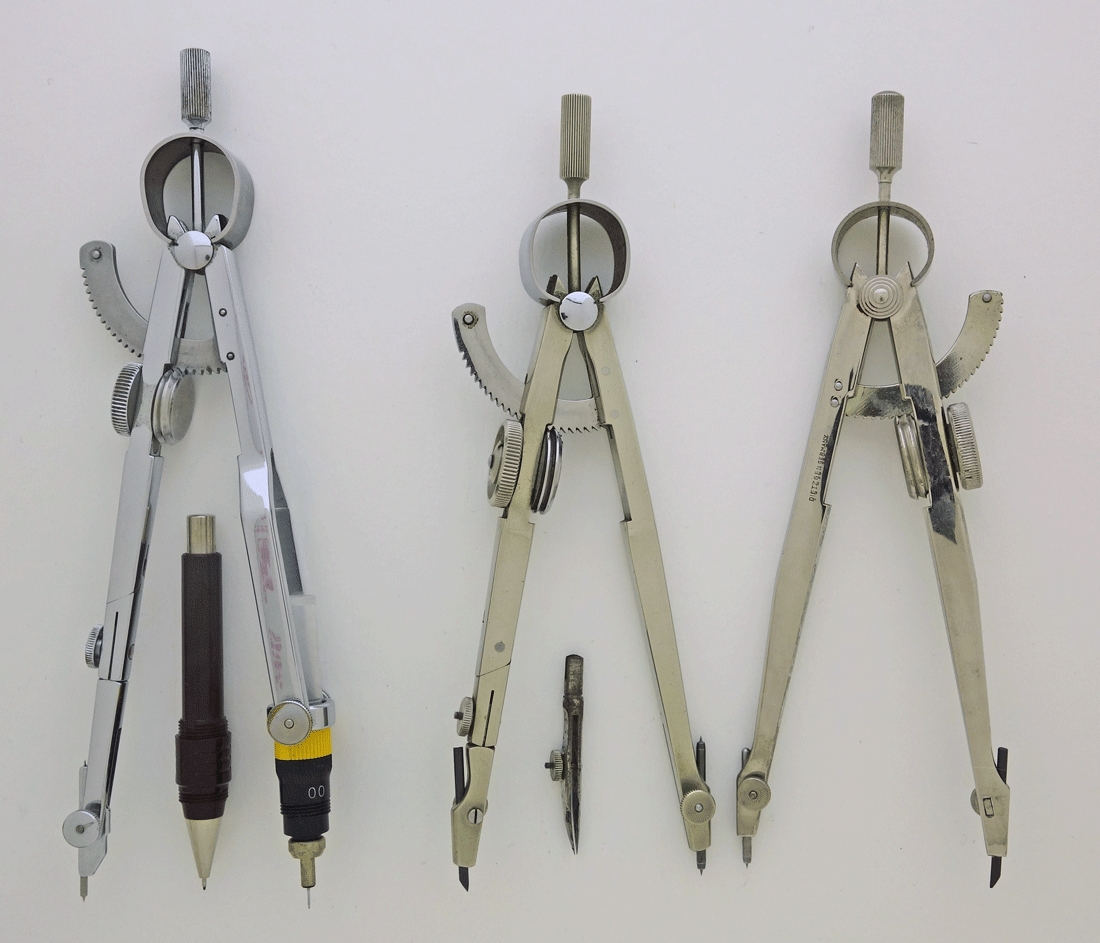Quickset compasses; Wing Compasses.
Modern Quickset or SpeedBow compasses are, in my opinion, not very good compasses. They all use a fundamentally flawed design. I find this odd since there is an excellent design for quick set compasses which has been around for many centuries, almost a millennium. It is quite likely that the expert practitioners of the art in medieval Islamic lands used this design. I do not know of any illustration to prove that suspicion, but this design has been used in Europe for at least 800 years. I am sure that it was known and used in the Levant and Persia as well.
Riefler Quick Set Wing Compass 1970s
This chromed example is from the 1970s but Riefler made this model for about 30 years. They are uncommon, but not rare.
These tend to be inexpensive since people are not quite sure what they are.
The idea of a wing compass has been around for a very, very long time. In the case of this design we have examples from as early as the 1500’s and illustrations from the 13th century notebooks of Villard de’ Honnecourt and several other medieval masons as well as a pair of remarkably detailed illustrations of a wing compass in use in manuscript illuminations of “God circumscribing the firmament.” For this particular drawing instrument we have an unusually clear view of technology in the medieval period.
There is nothing new here.
This Wing Compass dates from the 17th century and has a design essentially identical to the Riefler.
The single substantive difference is that it does not have an exchangeable marking leg. It would have been used as a steel point compass.
Osnabrück
© Smithsonian Institution: National Museum of American History.
The Osnabrück compass is in all functional respects identical to the Riefler compass of the 1970s, but the idea is even older. We know from the medieval illustrations that use of this design was already quite common in stonemasonry and other arts in the 13th century so it is probably very much older.
God The Geometer
God circumscribing the firmament from the 1220s; the same design.
Rough setting wing, fine setting screw knob on the leg.
That’s the same design
This one even has a finger post in the modern tradition. He is using it correctly.
This is a remarkable case of a drawing instrument with a stable design for almost 800 years. In those 800 years some changes were made. Exchangeable points in the Riefler model allow use of a single compass for lead layout or ink. This is an economy but it is not clear that it is an improvement. And you got chrome.
Essentially the same wing compass design is still used for metal work layout compasses which need to be very stable for use in scribing layout on metal.
There is one other model to mention since it is much more common as a used instrument. It was available new until 2019. The quick set wing compass, Schnellverstellzirkel, from Gebrüder Haff was sold by Haff, Keuffel & Esser, Koh-i-Noor and Rotring. An essentially identical compass was sold by Dietzgen. It marries an easier and faster disconnecting screw set to the wing design. These are exceptionally well designed and made instruments.
Haff Schnellverstellzirkel, 1950s to 2019.
An excellent compass design.
Notice that this is a screw set wing- and therefore it requires a spring head.**
When you release the quickset adjustment thumbwheel, by pulling it down to release the wing, you will find out just how much tension is exerted by this spring head design. Have a hand on both legs when you do.
This is a layout compass; it has a pencil point only. This is the most stable and accurate design- with the fewest joints.
** The spring is under the fine adjust nut in the 17th century and Riefler models.
This design had a very long production run and was made in three main types. They are all shown below.
Haff, By Koh-i-Noor, Haff by Keuffel & Esser, Dietzgen
From right to left, these are a standard pencil layout version by Dietzgen from the 1950s, a standard exchangeable leg pencil layout and steel pen compass from Keuffel & Esser from the 1950s in the center and the last “Universal Fork” design from Haff. The compass on the left is probably the most common used professional instrument in this class since it was developed last in the series.
This last design is a specialist compass designed for the technical pen. Technical, or Rapidograph pens were developed in the 1940s, common by the 1960s. The “Universal Fork” is threaded for the technical pen threads of the day. They are by far most common in Koh-i-Noor Rapidograph M10 0.75 thread which is still the industry standard for technical pens.
This compass also has some accessories which allow it to be used as a normal pencil layout compass. This is an example of adapting a highly specialized instrument to do something which it was not designed to do, but this is more successful than usual. It can take a 2 mm lead adapter, usually found in the set. It also takes a specialized mechanical pencil adapter. This pencil is threaded in the same thread as the technical pens specially to fit this class of compass. These pencils are still made in 0.5 mm and 0.3 mm but are getting expensive. If you have been reading all of these posts, you will probably be curious why this has both a needle shoe, to keep the steel point vertical, and a knuckle in the steel point leg. Normal practice is one or the other. It is to takes a well designed extension bar. I don’t like extension bars on bow compasses, but this one works reasonably well.
The knuckle allows the extension bar to sit parallel to the paper. This is a compromise within a compromise but that is not uncommon. This job belongs to a pencil beam compass. If you don’t have one, this works reasonably well.
The wing compass designs shown here are by far the best solution to QuickSet compasses. It is worth seeking one out. The final “Universal Fork” design was retailed by Rotring for many years and is reasonably common. As of today there are about 8 - 10 for sale on ebay. The more traditional layout compass is less common but an example is usually to be found listed at any given time. As always, the best instruments are the professional instruments of the 1970s. The best QuickSet compasses are also from that era.






